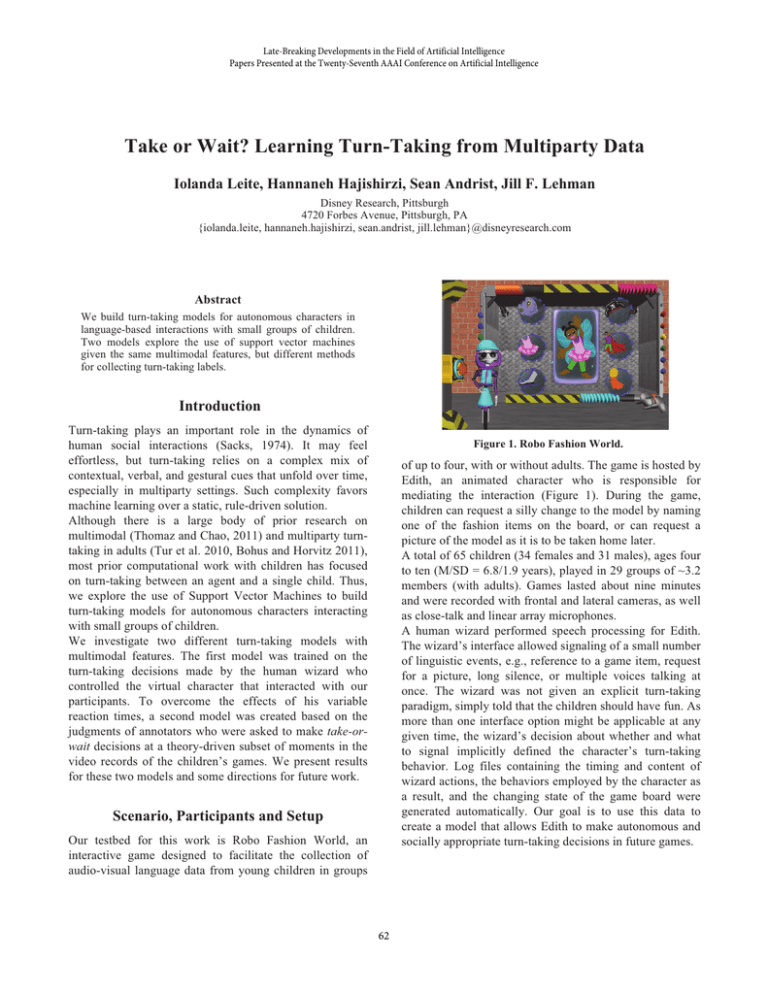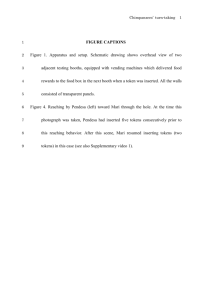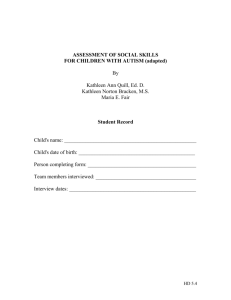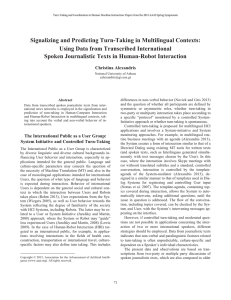Document 13897642
advertisement

Late-Breaking Developments in the Field of Artificial Intelligence
Papers Presented at the Twenty-Seventh AAAI Conference on Artificial Intelligence
Take or Wait? Learning Turn-Taking from Multiparty Data
Iolanda Leite, Hannaneh Hajishirzi, Sean Andrist, Jill F. Lehman
Disney Research, Pittsburgh
4720 Forbes Avenue, Pittsburgh, PA
{iolanda.leite, hannaneh.hajishirzi, sean.andrist, jill.lehman}@disneyresearch.com
Abstract
We build turn-taking models for autonomous characters in
language-based interactions with small groups of children.
Two models explore the use of support vector machines
given the same multimodal features, but different methods
for collecting turn-taking labels.
Introduction
Turn-taking plays an important role in the dynamics of
human social interactions (Sacks, 1974). It may feel
effortless, but turn-taking relies on a complex mix of
contextual, verbal, and gestural cues that unfold over time,
especially in multiparty settings. Such complexity favors
machine learning over a static, rule-driven solution.
Although there is a large body of prior research on
multimodal (Thomaz and Chao, 2011) and multiparty turntaking in adults (Tur et al. 2010, Bohus and Horvitz 2011),
most prior computational work with children has focused
on turn-taking between an agent and a single child. Thus,
we explore the use of Support Vector Machines to build
turn-taking models for autonomous characters interacting
with small groups of children.
We investigate two different turn-taking models with
multimodal features. The first model was trained on the
turn-taking decisions made by the human wizard who
controlled the virtual character that interacted with our
participants. To overcome the effects of his variable
reaction times, a second model was created based on the
judgments of annotators who were asked to make take-orwait decisions at a theory-driven subset of moments in the
video records of the children’s games. We present results
for these two models and some directions for future work.
Figure 1. Robo Fashion World.
of up to four, with or without adults. The game is hosted by
Edith, an animated character who is responsible for
mediating the interaction (Figure 1). During the game,
children can request a silly change to the model by naming
one of the fashion items on the board, or can request a
picture of the model as it is to be taken home later.
A total of 65 children (34 females and 31 males), ages four
to ten (M/SD = 6.8/1.9 years), played in 29 groups of ~3.2
members (with adults). Games lasted about nine minutes
and were recorded with frontal and lateral cameras, as well
as close-talk and linear array microphones.
A human wizard performed speech processing for Edith.
The wizard’s interface allowed signaling of a small number
of linguistic events, e.g., reference to a game item, request
for a picture, long silence, or multiple voices talking at
once. The wizard was not given an explicit turn-taking
paradigm, simply told that the children should have fun. As
more than one interface option might be applicable at any
given time, the wizard’s decision about whether and what
to signal implicitly defined the character’s turn-taking
behavior. Log files containing the timing and content of
wizard actions, the behaviors employed by the character as
a result, and the changing state of the game board were
generated automatically. Our goal is to use this data to
create a model that allows Edith to make autonomous and
socially appropriate turn-taking decisions in future games.
Scenario, Participants and Setup
Our testbed for this work is Robo Fashion World, an
interactive game designed to facilitate the collection of
audio-visual language data from young children in groups
62
Feature Extraction
The Annotator Model (MA)
Using the audio, video, and interaction logs, annotators
extracted a set of behavioral and contextual features for
each child. Video was used for head orientation (toward or
away from Edith) and gesture (head shakes, pointing and
emphasis). The close-talk microphone recordings were
used to define six additional features for each utterance.
Pitch, power, and prompt (a dialog context feature) were
derived automatically. Addressee (whether an utterance
was to Edith or not), yes/no words, and valid asset words
(references to a fashion item visually available on the game
board) were labeled by hand.
To overcome the reaction time lag in MW, we asked two
annotators to make take-or-wait decisions at the end of a
subset of video segments of the children’s games. The
video segments began immediately after Edith changed the
board and stopped at moments where, according to theory,
it is appropriate to take the turn (e.g., after a long silence or
at the end of a child’s utterance). Every end-of-utterance in
all 29 sessions was included in the set as well as an evenly
distributed number of silences that did not occur at the end
of utterances. Inter-rater agreement for the 4949 segments
was high (k = .739, p < .001).
Using the same features described above, we then built MA
from the ~4000 segments where the annotators agreed. As
with MW, we explored multiple versions of MA in a 29-fold
cross validation and found that accuracy to its own ground
truth peaked at two seconds of history. Table 1 shows that
when take/wait labels are paired with the features that exist
at the moment the decision is made, the feature set is able
to capture much of the regularity in the annotators’
decision making. We conjecture that MA might, in fact, be
a better representation of the wizard’s intent than MW.
The Wizard Model (MW)
With LibSVM (Chang and Lin 2011), the extracted
features were used to train a binary classifier that predicts
whether Edith should take the turn or wait at every 500
msec boundary (the time slice to be used in the
autonomous character to balance component synchrony
against perceivable delay). The training labels for MW were
based on the actions taken by the wizard during data
collection. A take occurred at the end of a time slice in
which the wizard performed an interface action. Slices
while Edith spoke were excluded from the model because
at present her speech cannot be interrupted (we anticipate
building a complementary hold/release model when she
can be). The remaining slices were assigned waits. MW has
three key characteristics: it encodes decision making at
every moment by a human in situ; it reflects the inherent
reaction time lag between a take decision and an action at
the interface during which feature values may have
changed; under the extant decisions, children had fun.
Several versions of MW were built and tested with 29-fold
cross validation against the wizard’s behavior. Versions
differed with respect to the number of prior time slices
included, ranging from no prior history to feature vectors
using eight previous slices (four seconds). Accuracy
improved significantly up to four slices (two seconds) of
history, and then flattened.
As Table 1 shows, MW is a poor match to the wizard’s
actual decision making. This might be because the model’s
features do not capture regularities in the wizard’s
decisions, but we believe it is more likely due to the
variable delays between when the wizard made his
decision and when he signaled that decision at the
interface. Indeed, given the large amount of overlapping
speech in our games, the conditions MW appeared to be
reacting to could be quite different from the conditions at
the time of intent, particularly because our models encode
ongoing behavior over a two-second window.
Table 1. Performance with history = 4 time slices/2 seconds.
Model
MW
MA
Max F1
0.40
0.82
AUC
0.51
0.67
TPR
0.68
0.83
TNR
0.75
0.81
Of course we cannot tell from these results whether MA is a
good turn-taking model or one under which children would
have fun. It is also important to note that MA is of potential
value only because its data were reactions to the same real
behavior as MW. We cannot stop the world to capture the
wizard’s decisions at the moment of intent, so it is the
combination of the data generated by the wizard and the
annotators that is critical to MA’s potential success.
Conclusions and Future Work
This work is a first step towards building turn-taking
models that enable virtual characters to decide when they
should take the turn in open-ended multi-child interactions.
We presented the results of two models built using the
same multimodal features but different approaches for
collecting turn-taking labels. To further understand the
differences between these models, we are planning to
conduct a study to evaluate the impact of the different
models’ predictions across the full data set by asking
subjects what they would do in situations where the
models’ actions differ. We also intend to compare the
SVM-based models with a baseline model where the turntaking decisions are purely rule-based.
63
References
Bohus, D., and Horvitz, E. 2011. Decisions about turns in
multiparty conversation: from perception to action. In
Proceedings of the 13th international conference on multimodal
interfaces, ICMI ’11, 153–160. New York, NY, USA: ACM.
Chang, C.-C., and Lin, C.-J. 2011. Libsvm: a library for support
vector machines. ACM Transactions on Intelligent Systems and
Technology (TIST) 2(3):27.
Sacks, H., Schegloff, E. A. and Jefferson G. 1974. A simplest
systematics for the organization of turn-taking for conversation.
Language, 696–735.
Thomaz, A. L., and Chao, C. 2011. Turn-taking based on
information flow for fluent human-robot interaction. AI Magazine
32(4):53–63.
Tur, G., Stolcke, A., Voss, L., Peters, S., Hakkani-Tur, D.,
Dowding, J., Favre, B., Fernandez, R., Frampton, M., Frandsen,
M., Frederickson, C., Graciarena, M., Kintzing, D., Leveque, K.,
Mason, S., Niekrasz, J., Purver, M., Riedhammer, K., Shriberg,
E., Tien, J., Vergyri, D., and Yang, F. 2010. The calo meeting
assistant system. IEEE Transactions on Audio, Speech, and
Language Processing, 18(6):1601–1611.
64




